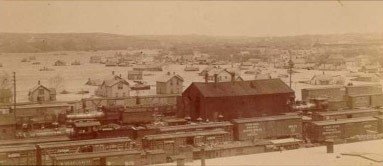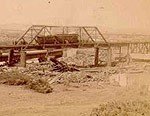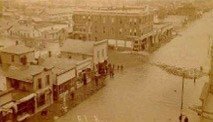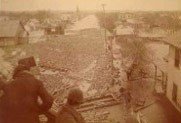Floyd River Flood of 1892
Spring of the year 1892 came like many before. The Missouri and the Floyd Rivers were swollen but seemed to be under control. Unlike previous years, it had been raining steadily for the past three weeks. May 16 had been a day of constant downpour of rain. On the evening of May 17, the Floyd began to rise, but no one appeared concerned.
About 6:00 a.m. the next morning a huge wave of muddy water rolled through the city. The citizens were not prepared. People were climbing trees, climbing on their house roofs and up onto the elevated railroad line to avoid being swept away by the swirling waters. At its high point the river swept from the base of Floyd's Bluff to Court Street by way of Fourth Street.
More than 3,000 people were left homeless. The lumber yards, stockyards and railroad lines were all severely damaged. The Queal lumber yard located on Third and Stueben caught on fire, adding to the confusion.
Cattle and hogs were swept away from the stockyards and railroad cars and their tracks were torn apart by the wave of water. The cedar blocks used for paving were dislodged.
The hardest hit area in town was Leeds. Water poured through the streets of the area. The hilly area north of Sioux City had received a lot of rain and it all drained toward Leeds. Levees that had been built to the north to hold the water back instead held the water in. Floyd Avenue and Leeds boulevard were under water and mud.
The cost to the city was staggering. Newspaper accounts at the time listed the death toll, by drowning, to be ten (10) and the damage at more than half a million dollars. The death toll was raised to twenty-five (25) in Army Corps of Engineer records prepared in the 1960s. This was the second most deadly flood in Sioux City history.
One man, Andrew G. Anderson, a 38-year-old Swedish immigrant spent the day rescuing all the people he could locate. He was a very good swimmer and good with a boat. He is credited with saving 27 people from death that day. He died while trying to rescue another family. A monument to this brave man was built in Logan Park Cemetery in his honor.








